
Despite a rapid increase of mass shootings across the country, there’s no official count of the total number of firearmscurrently distributed in the U.S. According to multiple reports, gun ownership in America is higher than any other country in the world, with an estimated 393 to 405 million firearms owned by civilians. By this calculation, there are more handguns in the United States than there are people: more than 120 guns for every 100 residents. In addition to a lack of transparency around the total number of firearms in the U.S., laws for legally owning, carrying, and transporting guns in America can vary wildly from state to state. Only the Brady Handgun Violence Prevention Act of 1993 requires anyone in the United States seeking to purchase a gun must submit to a background check issued by the FBI and the National Instant Criminal Background Check System (NICS). According to some analyses, it’s easier to buy a handgun in America than to get a driver’s license from the DMV or purchase tickets to a Beyoncé concert, but is that really accurate? For a closer look at firearm background checks in the U.S., we analyzed two decades of data from the NICS. Read on as we break down the increases in NICS background checks across the country; the leading reasons that legal handgun sales are denied; and how increases in background checks for weapons fluctuate in the wake of highly publicized mass shootings.
A Steady Incline
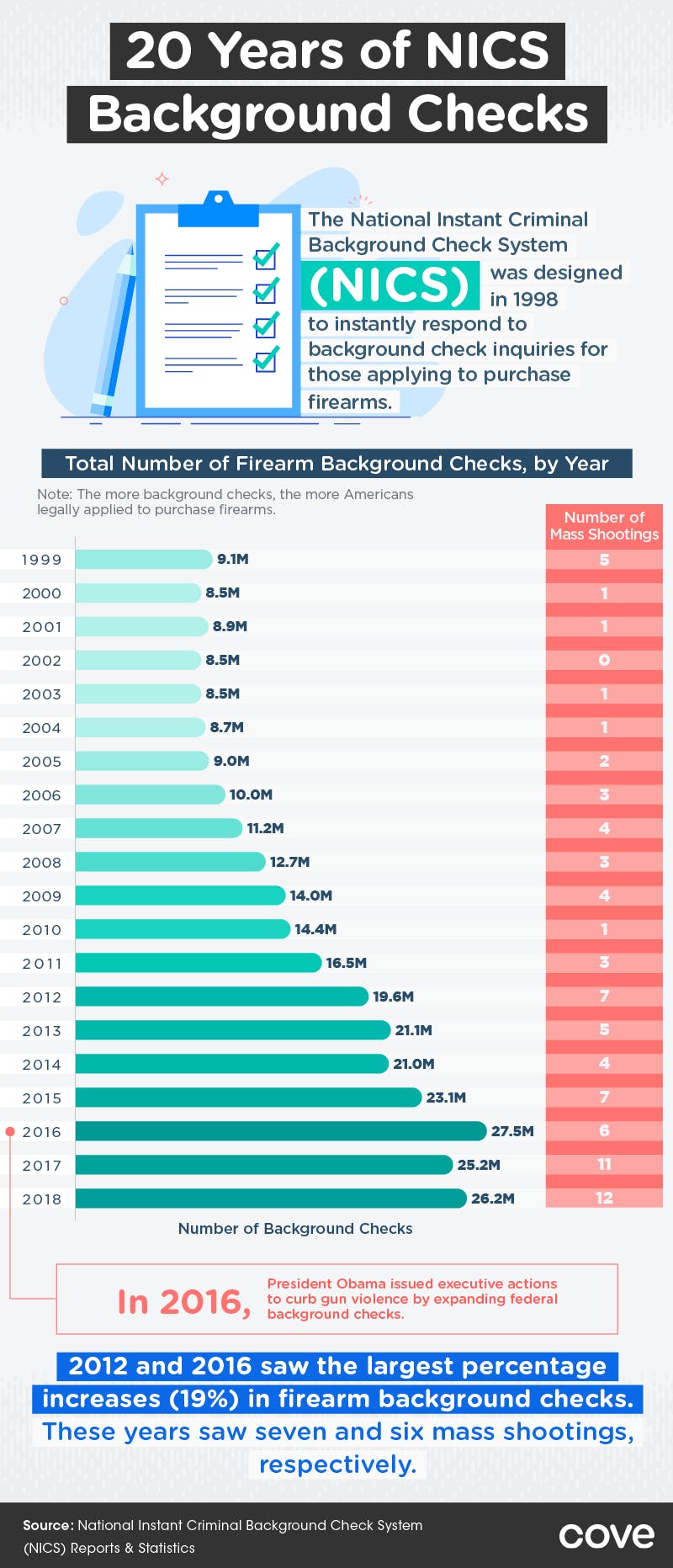
While there’s no official number of legally purchased firearms in the U.S., the FBI has been tracking background checks for the purchase of guns through the NICS since 1998. A successful background check does not directly signify the purchase of a firearm, however, more background checks in a single year implies that more Americans are legally applying to purchase them. In 1999, there were 9.1 million NICS background checks for the purchase of firearms with relatively minor fluctuations through 2005. In 2006, 10 million Americans submitted for NICS firearms checks for the first time in recorded history, a figure that more than doubled to 21.1 million in 2013. Despite reaching its highest point in 2016 (27.5 million), we found more than 26 million NICS background checks for firearms in 2018. In 2012, the year of the Sandy Hook Elementary School shooting, background checks for firearms spiked by nearly 19%, reaching 19.6 million. While there were an average of 2.2 mass shootings every year between 1999 and 2011, 2012 saw 7 mass shootings for the first time since NICS checks were introduced. In 2016, the year of the Pulse nightclub shooting, the 27.5 million NICS background checks equated to a 19% increase over 2015. In 2017, the number of mass shootings in America spiked to 11, followed by 12 mass shootings in 2018.
Denied Requests for Gun Sales
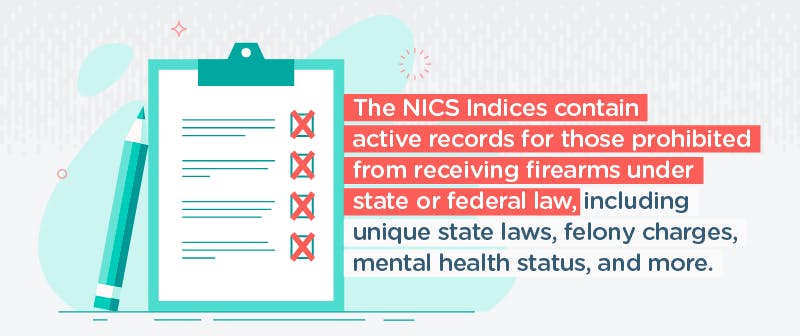
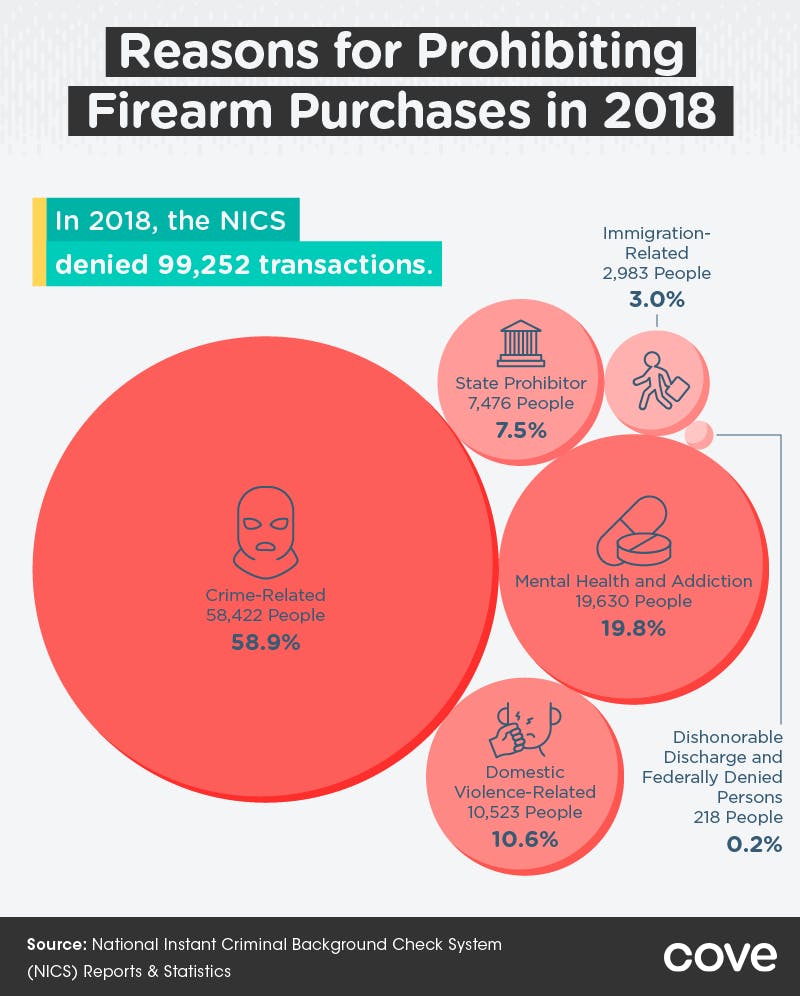
Of the 99,252 transaction denials based on NICS background checks in 2018, nearly 59% were the result of crime-related rejections. Almost 1 in 5 transaction denials were attributed to mental health and addiction, and roughly 1 in 10 were rejected due to a record of domestic violence. According to federal law, mental illness only blocks the sale of firearms if the person has been involuntarily committed to a mental institution or if a court declares them mentally incompetent. Despite having been evaluated at least three times by a mental health institution and recommended for treatment under the Baker Act, Nikolas Cruz, the single assalinet of the 2018 mass shooting at Marjory Stoneman Douglas High School in Parkland, Florida, was still legally allowed to purchase a semi-automatic rifle.
Regional Gun Sale Attempts
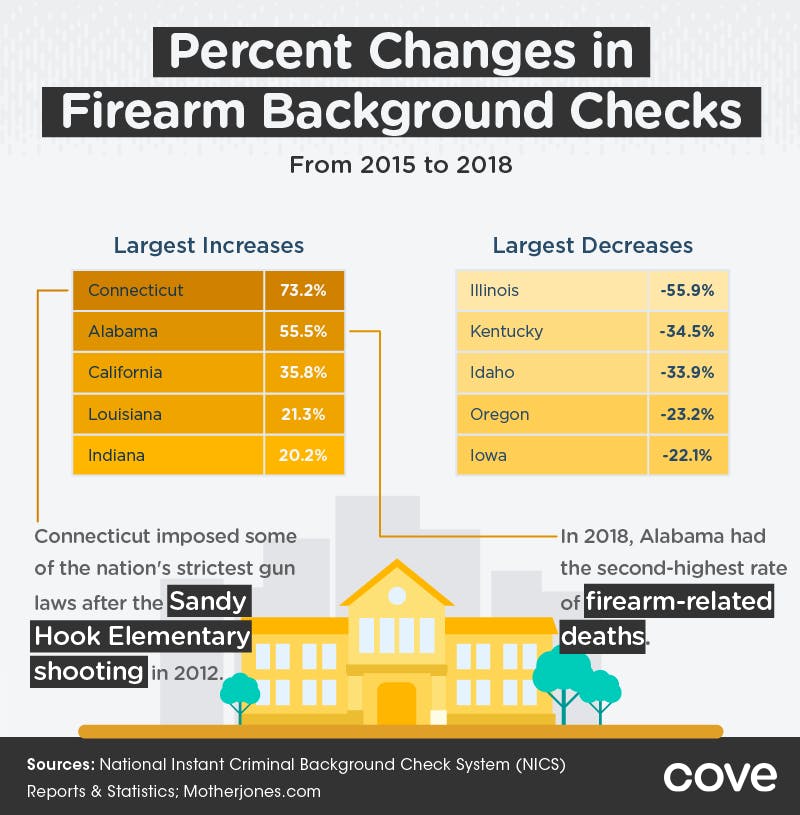
Between 2015 and 2018, the largest increases in the number of residents attempting to purchase firearms occurred in three states: Connecticut (73.2%), Alabama (55.5%), and California (35.8%). Since the tragic Sandy Hook Elementary School shooting in 2012, state lawmakers have made drastic changes to the laws regarding the sale of firearms, banning more than 150 gun models and the sale of magazine clips that hold more than 10 rounds. While these laws may not have reduced the number of guns sold in Connecticut, they are linked to a dramatic decrease in the number of homicides occurring across the state. And while Illinois is the only state in the country to require residents to obtain a Firearm Owner’s Identification card before legally obtaining a weapon, Chicago remains one of the deadliest cities in America for lethal gun violence. Illinois also saw the greatest percentage decrease in NICS background checks between 2015 and 2018 – nearly 56%.
Differentiating State Gun Laws

Due to a lack of overarching national gun policy, states in the U.S. have established their own legislation and gun regulations. As a result, these inconsistencies from state to state make it much easier to buy guns in some states than others. For example, in Arizona, you don’t need a permit to buy a handgun or a rifle, and the state does not require residents to register purchased weapons. In Alaska, residents are allowed to carry guns either openly or concealed without having a permit to do so.
More Than Firearms
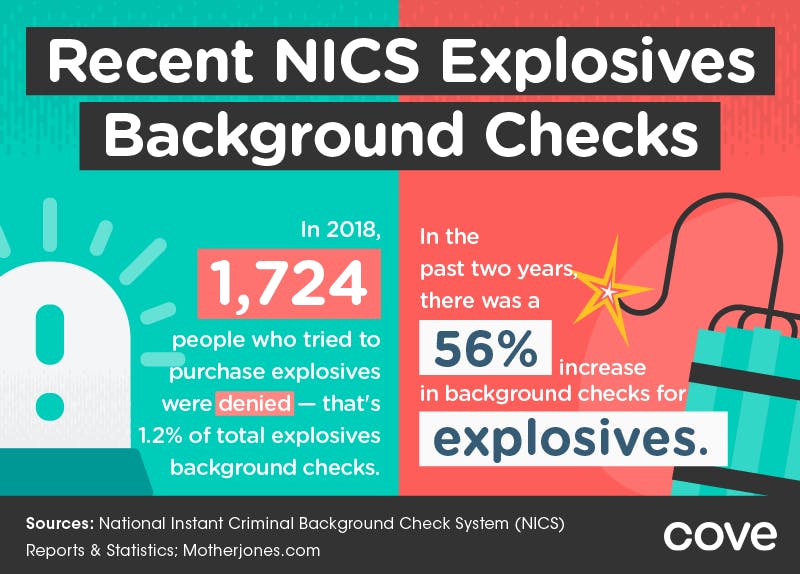
Like firearms, the FBI and NICS also work to regulate the legal purchase of explosives. Between 2016 and 2018, there was a 56% increase in the total number of background checks for the purchase of explosives. Similar to the very small percentage of firearm background checks that are denied every year, just 1,724 people were refused explosives purchases in 2018, equating to only 1.2% of people who applied to purchase them.
An Immediate Response
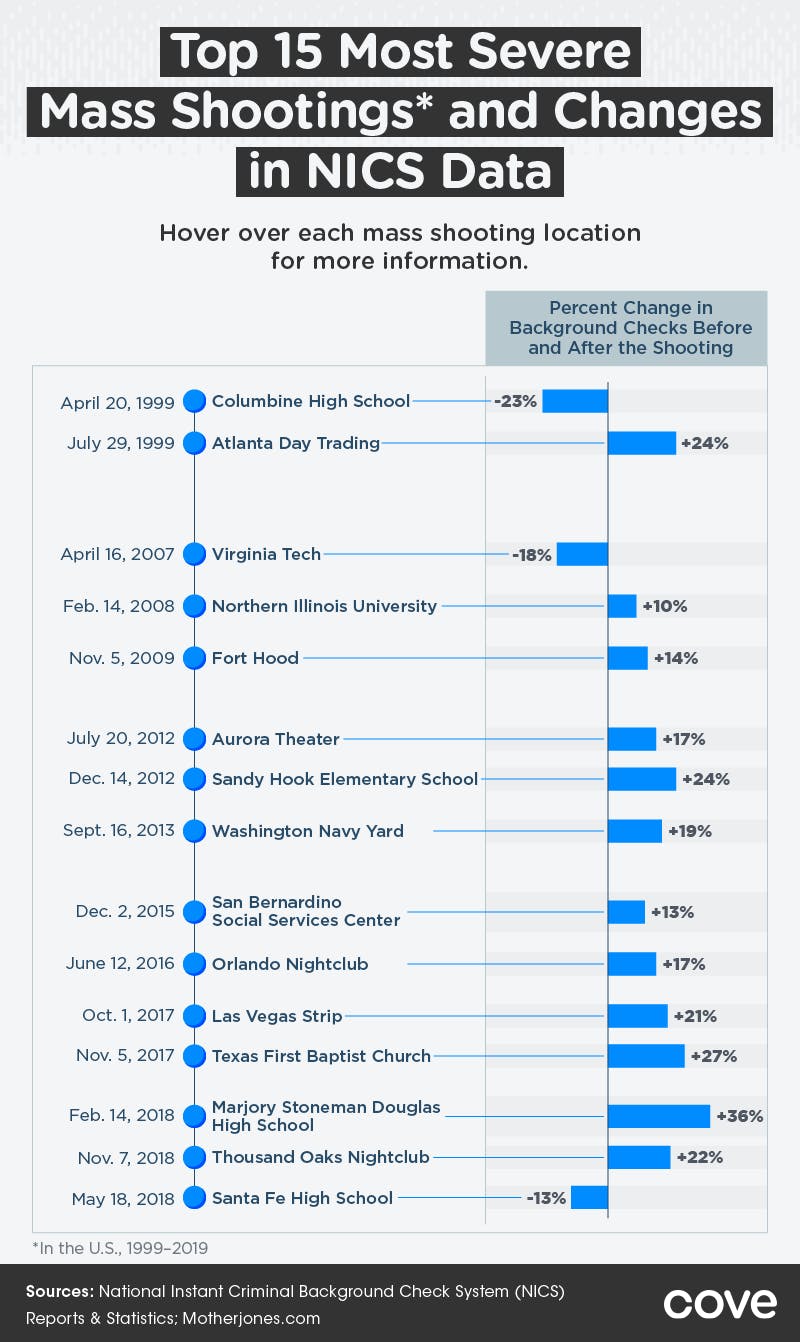
In the U.S., highly publicized mass shootings are typically followed by a spike in NICS checks. Triggered perhaps by a combination of fear and panic for public safety, or a concern by some that gun sales may soon be restricted after these events, mass shootings almost always correlate to a dramatic increase in the number of firearms sought in America. Among the 15 deadliest mass shootings in the U.S. since 1999, just three have led to an immediate decrease in the number of NICS checks after the tragedy. Columbine, in 1999, drew a 23% decrease in the total number of NICS checks, followed by the Virginia Tech shooting in 2007 (18%) and Santa Fe High School shooting in 2018 (13%). Despite demands for changes to U.S. gun laws by several of the survivors of the Marjory Stoneman Douglas High School shooting in 2018, NICS background checks for the purchase of firearms spiked highest (36%) before and after this tragedy compared to any other mass shooting in the last 20 years.
Seasons Greetings?
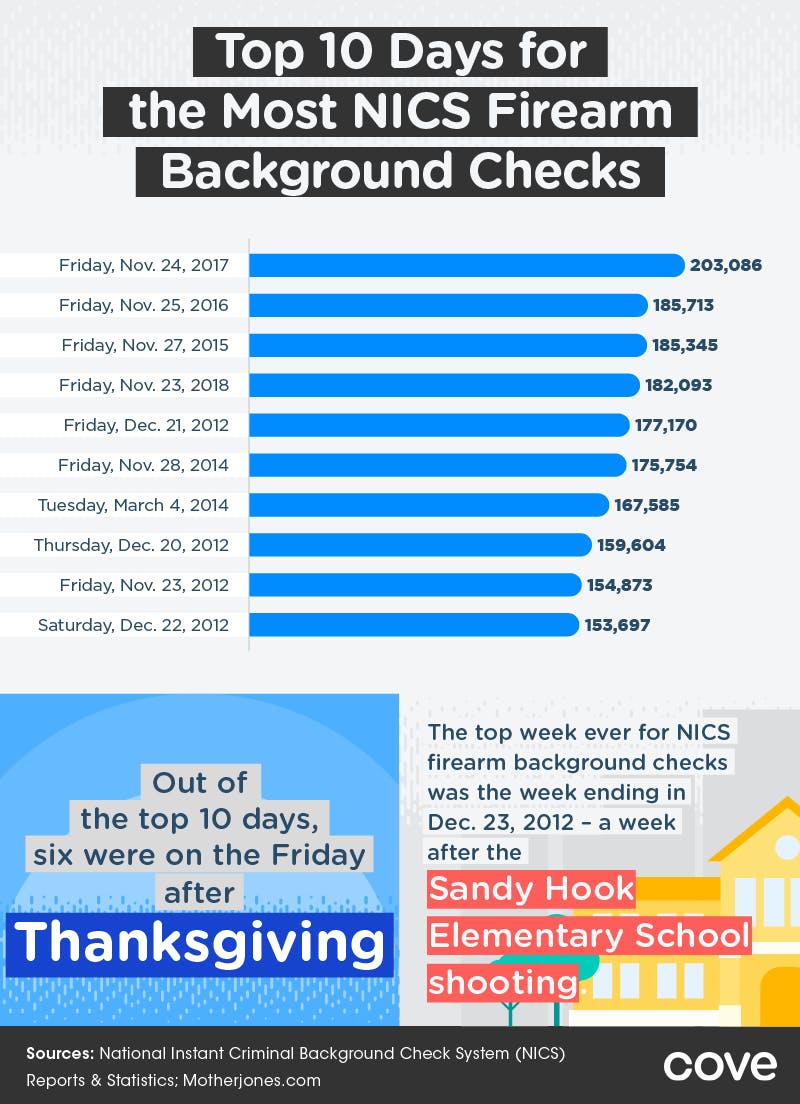
Among the most popular days for NICS firearms background checks between 1999 and 2018, six out of 10 occurred the Friday after Thanksgiving.Three also occurred the Thursday, Friday, and Saturday immediately following the Sandy Hook Elementary School shooting in 2012, which also coincided with just before Christmas. During the holiday season, there are no federal laws prohibiting residents from purchasing firearms to give to relatives or friends who live in the same state. Eight states and Washington, D.C., require the gift-giver to transfer the firearm through a local firearms retailer, forcing a NICS background check. Over the same 20-year period, the highest week in the U.S. for NICS firearms background checks was the week ending Dec. 23, 2012. November, another common month for high volumes of NICS background checks, also coincides with the beginning of deer hunting season in many states.
Finding Peace of Mind
Alarm systems can alert you when an unwelcome guest enters your home or business. If this person has a gun, the alarm gives you more notice so you can fight, hide, or flee. In addition to that the authorities will be called to your aid. At Cove, we’re passionate about making sure you have peace of mind at home and away. Our DIY home security system gives you five-star safety without contracts or commitments. Not only will you get the best protection our technology has to offer, but also you’ll get fair and transparent pricing, so you know how much you’re spending and why. You deserve to feel safe with Cove’s security systems. Learn more by visiting us at CoveSmart.com today.
Sources
- https://www.thetrace.org/rounds/how-many-guns-do-americans-own/
- https://www.dw.com/en/8-facts-about-gun-control-in-the-us/a-40816418-0
- https://mashable.com/2016/06/18/things-harder-to-get-than-a-gun/
- https://www.wnpr.org/post/whats-been-impact-connecticuts-gun-laws-after-sandy-hook
- https://www.fbi.gov/services/cjis/nics
- https://www.axios.com/chicago-gun-violence-murder-rate-statistics-4addeeec-d8d8-4ce7-a26b-81d428c14836.html
- https://money.cnn.com/2018/02/15/news/companies/us-gun-sales-decline/index.html
- https://www.cnn.com/2019/02/11/us/parkland-change-gun-control-legislation/index.html
- https://www.nssf.org/giving-a-firearm-as-a-gift-some-reminders-from-nssf/
- https://www.wsj.com/articles/how-many-guns-do-americans-own-1540997454
- https://www.newsweek.com/mental-health-provider-evaluated-parkland-shooter-nikolas-cruz-services-1131644
- http://www.eregulations.com/northcarolina/hunting-fishing/deer-hunting-seasons/Methodology and LimitationsFor this project, we analyzed data from the National Instant Criminal Background Check System (NICS) Reports & Statistics, as well as the Mother Jones Mass Shootings Database from 1982 to 2019. For the NICS Reports & Statistics, we analyzed data from the 2018 Operations Report, Active Records in the NICS Indices, Active Records in the NICS Indices by State, Federal Denials from 2008 to 2018, NICS Firearm Checks: Month/Year, NICS Firearm Checks: Month/Year by State, and NICS Firearm Checks: Top 10 Highest Days/Weeks. Since the NICS data was activated on Nov. 30, 1998, and this study was conducted in 2019, visualizations that show “by year” excluded 1998 and 2019, as the data would be incomplete for those years. As a limitation of this study, it is important to note that not all 50 states are required to process DOF background checks. According to the NICS, “The NICS Indices, a database created specifically for the NICS, contains information contributed by local, state, tribal, and federal agencies pertaining to persons prohibited from possessing or receiving a firearm pursuant to state and/or federal law. Typically, the records maintained in the NICS Indices are not available via the III or the NCIC. As of December 31, 2018, the NICS Indices contained 19,318,610 records. Currently, 38 states, 25 tribal, and 35 federal agencies process Disposition of Firearms (DOF) background checks.” As another limitation of the study, it is important to note that entry into the NICS Indices on people prohibited from receiving firearms is not always necessary. According to the NICS, “The NICS Indices contain information provided by local, state, tribal, and federal agencies of persons prohibited from receiving firearms under state or federal law. If the information is available in the NCIC or the III, entry into the NICS Indices is not always necessary. Therefore, certain categories within the NICS Indices may show minimal or no participation by a state or federal agency.” Additionally, “on the state level, unless otherwise instructed by state law or federal funding requirements, participation in the NICS Indices is strictly voluntary.” It is also important to note that firearm purchases can and do occur outside of the processes involving the NICS, such as at private gun shows. These firearms are sold by unlicensed sellers, and they are not mandated to run background checks. Therefore, the number of background checks is not indicative of the actual number of Americans who have requested to purchase firearms. When looking at visuals for 2018, it’s important to note that NICS records grew significantly that year. According to the NICS, “The NICS Section’s research proficiencies were enhanced in 2018 after an increase of 1,919,149 records were submitted into the NICS Indices by multiple agencies. The NICS Indices include individuals who have been determined to be federally or state prohibited from possessing or receiving a firearm and the disqualifying information may not be available through the National Crime Information Center or the Interstate Identification Index systems.” In this project, a mass shooting event was defined as an event that affected three or more total victims. Population data for per-capita calculations was reported by the U.S. Census Bureau, Annual Estimates of the Resident Population for the United States, Regions, States, and Puerto Rico: April 1, 2010, to July 1, 2018.Fair Use Statement Are your readers interested in learning more about how gun ownership in America has changed over time? We welcome the sharing of our findings for any noncommercial use with the inclusion of a link back to this page as a credit to our team.
